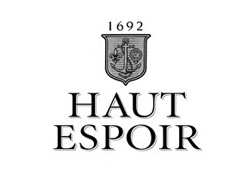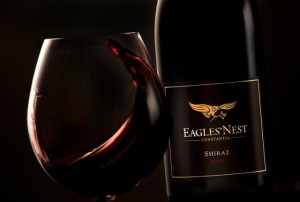The post Ditch Secret Santa. Time for #SecretStellies appeared first on Incogvino.
]]>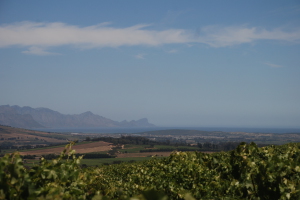
#SecretStellies – The Setting
‘Tis the season and all that, but if you’re like me and you’re struggling to get into the Christmas spirit (but you also desperately don’t want to be a grinch) then I may have just the solution for you. You see, while I love and have always loved the Festive season, I must admit that this being a grown-up gig has taken some of the magic out of the whole thing. Work, deadlines, last minute crises. And let’s not talk about the anxiety of figuring out leave and holiday arrangements. Bah! Humbug! Hardly things that make me want to wrap myself in tinsel and sing Fa-la-la-la-laaaa. So how do we combat The Grinch at this truly lovely time of year? What could we do to dust off the anxiety and “meh-ness” of 2014 and get ready to have some summer fun in the gorgeous winelands? Lucky for you all, I have a secret. It’s called #SecretStellies and it might just put you in the summer festive season mood.
#SecretStellies is a little project dreamt up by Lydia from Beau Joubert. I could write endless posts about the endless talents of this remarkable wine-lover but for now, just take note of her marvellous idea: Secret Stellenbosch. The idea is to showcase the real hidden gems of the area. With nearly 150 wine farms on the official Stellenbosch Wine Route, there is more than enough to see and do to keep any wandering wino busy for months. Visitors are often drawn to the bigger, more well-known farms simply because they’re hard to miss. Of course they also offer quality wines, activities and are well worth a visit. But smaller wineries that may not have the word-of-mouth presence of the more popular ones are often skipped. #SecretStellies aims to uncover these secret treasures of the winelands and give the public a little insight on what they may be missing.
The first #SecretStellies day out was organised with military precision and focused on the Polkadraai Hills area of Stellenbosch. We simply had to make our way to Beau Joubert – the first of three stops – and the rest would be taken care of by The Amazing Lydia. At BJ we were treated not only to a tasting of their wines and a nice gab about the whole #SecretStellies concept, but we were among the first people ever to taste the very first MCC from Beau Joubert. And let me tell you, it certainly was worth the wait. If you’d like to know more, keep an eye on the Beau Joubert Twitter feed. After sampling their mind-bogglingly fantastic value for money wines (seriously, most of them are R100 or less at cellar door. I highly recommend the Chenin Blanc, the Shiraz and the “Free-run” Merlot Rosé.) we took a leisurely stroll down the road to the neighbouring Bein wines, where they had a special experience waiting for us.
Bein Private Cellar is exactly the type of winery that sits at the heart of the #SecretStellies idea; a small operation run by Luca and Ingrid Bein – Swiss veterinarians who fell in love with South Africa and moved here to study and make wine. Their focus is Merlot and they produce a fantastic selection. Bein also offers an unusual winelands experience: a donkey walk. The donkey walk takes visitors on a walk through the vineyards, up to a lookout point and picnic spot. The donkeys carry delicious picnic fare and when you reach the top, Ingrid and Luca unpack the spread and the wine and a little feast is had, overlooking the magnificent surroundings. A good time was had by all, relaxing under the trees and digesting not only the nibbles but the view. You only have to chat with the Beins for 5 minutes to uncover their love for South Africa and their enthusiasm for wine. A visit to Bein Private cellar and a donkey walk should be on everyone’s summer to-do list.
Once we rolled ourselves back down the hill (after being fed beyond elegant sufficiency with the lovely picnic) we were loaded into and onto a bakkie and whisked off to Saxenburg for a Safari Wine tasting. And no, this is not some metaphoric comparison of the Saxenburg wines with The Big Five. Oh no. The tastings are held in a game camp with zebra, antelope and other wild game trotting about around you. No rhinos, elephants or wild cats of course, but if you sit back and stare into the veld, it’s difficult to imagine you’re in the winelands and not at a luxury game lodge.
We indulged in a tasting of Saxenburg’s finest, including their truly fantastic MCC (at R180 a bottle it really is a brilliant buy – unfortunately the label design does let it down immensely as it does not visually present itself as a near-R200 bottle of bubbles, but DO give it a try if you encounter it at your local. It gives the other bubbles in that price class a real run for their money!). Saxenburg has a great selection of wines, from a creamy Chardonnay to a supremely elegant Cabernet Sauvignon which on their own make the estate worth a visit.
And with the view of zebras in the distance (and the kerfuffle of finding of an ostrich egg next to the camp), our #SecretStellies day ended. I’ve always known that Stellenbosch – in fact, all the winelands areas – are a heady mix of the historic, the well-known, the crowd-pleasers, the small and obscure. The #SecretStellies adventure reminded me that the hidden gems must be discovered and talked about. A little exposure will hardly turn them into commercial punters but rather serve to share the secrets they hold with the world. And when that happens, everybody wins.
So if you’re short on some summer Christmas cheer, I recommend a visit to one of these secret spots. It might be just what the doctor Santa ordered . Ho, ho, ho!
The post Ditch Secret Santa. Time for #SecretStellies appeared first on Incogvino.
]]>The post On Fining Agents and Clarity appeared first on Incogvino.
]]>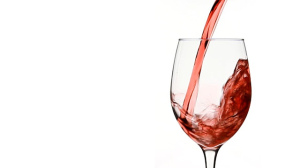
Wine – more than just fermented grape juice?
The Incogvino SuperFANS are all about the wine, and not just the tasting and the drinking. Being an inquisitive bunch, the following question popped up on our mailing list this week. “Egg protein? Milk protein? Is this normal?” with reference to a wine label with the aforementioned listed on it. This brought up the topic of fining agents and the question of not only what, but how, these processing aids are used in the making of wine. The science of fining agents can be quite complicated (some Chemistry 101: the molecules of fining agents have either positive or negative charges which affect the way they interact with the compounds in wine, which also have positive or negative charges. Science!) but the basics can be simple to understand. Here’s a quick clarification about fining agents in wine.
Let’s start by looking at why fining is important in the first place. When evaluating a wine, either formally for scoring or just looking at the liquid you’ve just poured into your glass, the preference is always for clarity. Clear wines are generally associated with quality and a healthy wine. Cloudiness could even indicate a fault in the wine, such as the growth of yeast or bacteira. Of course there are wines made in unfiltered styles which may present as hazy, but the majority of wines are filtered and clear.
Fining agents work to clarify wine by binding to the insoluble particles in wine which cause the murkiness. The process causes these substances to precipitate out of the wine in a solid state and settle at the bottom of the tank. Fining can also remove unwanted soluble compounds, such as phenols, polymerised tannins and other proteins as these will precipitate into an insoluble state upon binding with the fining agent. The clarified (fined) wine can then be separated from the insoluble material through a process called racking (removing the clear wine from the top and leaving the unwanted material at the bottom).
Now that we know why we use fining agents and how they work, let’s have a look at the types of compounds used in this process. Different fining agents are used depending on the type of wine. Some agents are more severe than others and can strip the wines of flavour and aroma compounds, so a balance between removing all unwanted substances and preserving desired ones is always important for winemakers to achieve. Some of these fining agents may seem fantastically odd, but keep in mind that they never actually form part of the wine – they are not food additives but rather processing aids – and precipitate out, separated completely from the wine that ends up in your bottle.
One of the most commonly used fining agents is bentonite, a type of clay. It is a very effective fining agent but over-fining can strip wine of flavour and colour and leave it with an earthy flavour. Egg white (albumen) is another popular choice for red wines as it has an additional affect of softening the tannins. Carbon (in the form of activated charcoal) is often used to remove off-colours and off-odours from wine. It is quite harsh and is not generally used as a typical fining agent, but rather for wines with significant problems. Casein (protein derived from milk), gelatine (an animal protein), isinglass (obtained from the swim bladders of fish), Kieselsol (silicon dioxide) and PVPP (poly-vinyl-poly-pyrrolidone) are other examples of agents, with varying specific uses to solve specific problems. Companies like Laffort are constantly researching alternative and improved fining agents, producing new products such as Vegecoll (a potato-derived protein) to clarify and stabilise wines.
A last note on fining agents is on the suitability of wines treated with various types of agents for vegetarians, vegans and people with food allergies. For most wine drinkers, the type of fining agent used is irrelevant as it is almost completely removed from the wine itself. After fining, clarification and stabilisation, wines are often filtered to remove the last possible particles and insoluble matter left. Trace amounts of fining agents (trace meaning on the absolute limit of detection – micro- or nanograms per litre) may remain in the wine and people with severely sensitive allergies may be affected. Strict vegans and vegetarians will also avoid wines who use animal-derived proteins (such as casein and albumen) as fining agents. VeganSA has a list of wine estates who produce vegan wines by using only non-animal derived fining agents.
The regulation around fining agents still seems a bit fuzzy. Declaring potential allergens on wine labels has become mostly standard practice, worldwide. Canada and the OIV (Organisation Internationale de la Vigne et du Vin) have recommended guidelines in place and some countries may be held to certain labelling practices when exporting wine. The general consensus seems to be that potential allergens should be listed, but many argue that if the filtering process efficiently removes these agents, listing them as additives on the labels may not be entirely accurate. It becomes even more confusing, as Europe applies “truth in labelling” law, the implication being if the label states eg. “Contains milk” (referring to casein) but the filtering process has removed all traces of casein, the winery is essentially breaking the law. This means a “better safe than sorry” approach isn’t really viable either.
Bottom line: don’t be afraid of fine(d) wines. The process may sound a bit strange (having made wine myself, I still find it counterintuitive to add a bucket of clay slush or some whipped egg whites to a tank of wine) but it’s all very scientific and the end result is healthy wines, with longevity and a crystal clear hue, making our favourite drink even more appealing.
For a more technical piece on the science behind fining, I recommend this Wineland technical post. You can also read more about the industry regulations and general good practice around fining agents and allergens in wine by checking out the SAWIS page and searching for the keyword “fining”.
The post On Fining Agents and Clarity appeared first on Incogvino.
]]>The post Nederburg – Hiding in plain sight appeared first on Incogvino.
]]>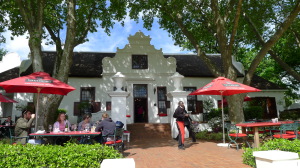
Nederburg Estate, Paarl
South African wine farms are diverse with many offering not just wine, but experiences, pairings and world-class gastronomic experiences. Diversity aside, there is a golden thread that runs through and binds many of our most well-known estates: history. Since the humble beginnings of our country as a halfway station between Europe and India, wine has been an established part of that history. Groot Constantia, Vergelegen, Blaauwklippen, Muratie, Alto (to name a few) were all established within the first century of the Dutch setting foot in the Cape. In 1791, Nederburg was bought by Philippus Bernardus Wolvaardt for 5600 guilders and the estate took its place in SA wine history. And this historical (and oenological) gem is hiding in plain sight.
As with most historic places, a visit to the estate is by far the best way to appreciate the heritage. Walking into the Nederburg tasting room, the history of the farm is set out in panels with beautiful images bringing to life the rich past of the estate. There is also a central display dedicated to their Heritage Heroes, a tribute to the owners and winemasters of the farm, incredible people with incredible stories that are represented by incredible wines.
The Heritage Heroes range consists of five wines. The Anchorman Chenin Blanc represents the first owner and winemaster of the estate, Philippus Wolvaardt, who had the vision and passion to create and establish Nederburg, paving the way for the estate we know today. The Brewmaster (Bordeaux blend) is a tribute to Johannes Graue, who co-owned a brewery in Germany before moving to South Africa to play his part in revolutionising the wine industry through clonal experiments and his attention to improving source material for the vineyards. The Young Airhawk Sauvignon Blanc commemorates Johan Graue’s son, Arnold. Arnold was known for his brilliance in continuing to improve winemaking and viticulture techniques but he died tragically in an a light aircraft crash at the age of 29. After the death of his son, Graue was devastated. He nearly quit the farm, but instead opted to go to Germany and bring back the next winemaster: Günther Brözel. Known for whizzing around the farm on his 250cc motorcycle, a fitting name for the wine to honour him is the Motorcycle Marvel (Rhône blend). The last wine to be released in the series was The Beautiful Lady (Gewürtztraminer), remembering Graue’s wife Ilse, who played an important part in making the estate what it is today. A beautiful wine for a beautiful lady.
Nederburg is one of the Distell brand homes and offers a number of wine ranges, suiting every taste and budget. These include the Foundation range, 5600, Winemaster’s Reserve, Manor House, Heritage Heroes and Ingenuity. The tasting room offers tastings of the different ranges as well as a “Which wine, which cheese” tasting with gorgeous locally sourced goats cheeses. The Manor House is home to The Red Table restaurant, bistro style fare with jaw-dropping views of the estate.
Tasting through the entire range offered at Nederburg is quite a task, so we skipped the Foundation and 5600 range as well as the Baronne and the Duet (not because of snobbish tendencies but because I’m very familiar with the ranges and wanted to invest time in some of the unknown wines). We ended up tasting 15 wines and I won’t prattle on with a review and overview of each wine, but the ones worth stocking up on include:
- Young Airhawk Sauvignon Blanc – Slightly wooded, zesty with mineral undertones and a smooth finish.
- The Beautiful Lady – Without a doubt, my favourite wine of the day. Inviting, engaging and beautiful and a gentle sweetness on the palate.
- Motorcycle Marvel – Silky, smooth tannins with good structure. Hit of acidity highlights fruit in the wine. Great summer red.
- The Brewmaster – Nicely wooded, complex with dark fruit and savoury notes. A warm, winter wine which would go well with stews, especially those of the French persuasion
- Edelrood (Cabernet Sauvignon/Merlot blend) – Easy drinking, juicy wine. Pine needles, eucalyptus hints from the Cab with great softness from the Merlot. Great “standby” wine for unexpected braais or pizza evenings.
- Winemaster’s Reserve Chardonnay – Straightforward. Honey tones on the nose, unassuming, middle-of-the-road Chardonnay. Not overly wooded, not overly fruity.
-
Ingenuity White – 8 varietal blend (Sauvignon Blanc led, with Chenin Blanc, Chardonnay, Riesling, Gewurtztraminer, Viognier, Semillon and Verdelho). A serious white wine. Rich, creamy finish with Riesling, Gewürtz and even the Viognier coming through on the nose. The 2013 is fantastically balanced, with the varietals not fighting each other in the bottle but rather working together to complement.
- Manor House Sauvignon Blanc – If you like green pepper Sauvignon Blanc, this one is for you. Chill as much as you dare and set it down by the pool to make the hot summer bearable.
To conclude, permit me a little waffle about perceptions. Nederburg is part of Distell and the Boutique-ONLY wine crowd will undoubtedly sniff and grumble at the thought of quaffing anything produced by “big corporate”. This attitude irks me no end as I am very familiar with many of the Distell brands and I know the quality that can be found in their products. Yes, it’s a massive company. Yes, it produces hundreds of products, some more “commercially accessible” shall we say, than others. It may not have the intimate, boutique-appeal that some farms champion and it may be far from a “hidden gem” but Nederburg caters for nearly all tastes. From the eternally dependable, staple of my student days Baronne (which I can still happily pick up at any wine shop and know exactly what I’m getting – there’s something to be said for consistency!) to the Heritage Heroes range through to the Ingenuity, Noble Late Harvest and the Edelkeur, Nederburg offers a little bit of everything for everyone.
The importance of heritage, history and passion for wine is also evident not only from the Nederburg story, but from each wine produced today. Many estates have the history and the heritage sites, but few make it as part of their every day story as Nederburg, where the essence of the winemasters echoes still in every bottle.
The post Nederburg – Hiding in plain sight appeared first on Incogvino.
]]>The post A Visit to Lithos {Guest Post} appeared first on Incogvino.
]]>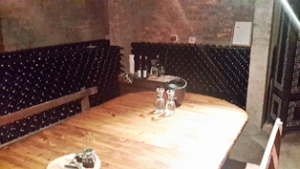
Lithos Cellar
After one of our most interactive and exciting Twitter tastings with Lithos wines, one of our SuperFANS, Stephen Brierley, went along to the farm to discover where the magic is made. If you want to follow Stephen on Twitter for his magnificent tweets about wine, you can find him at @sbrierley75. If you’d like to visit Lithos, contact them at @wines_lithos or visit their website.
I had a long overdue engagement with Tim Hoek, the winemaker from Lithos wines and just under two hours in traffic from Century City to Somerset West was not going to stop me. The farm is on Old Sir Lowrys Pass Road, on Wedderwill Country Estate. The Estate has another wine farm on its property, but that is a topic for another post. Lithos wine farm is situated between the Schapenberg mountain range to the east, the vistas of False Bay, that go on and on all the way to Cape point, to the west.
Lithos is owned by Sean and Lorraine. Sean is a financier, who still spends time travelling around the country on business, while Lorraine is an artist and a dreamer and conceptualised the name of the farm. Lithos comes from the word Lithosphere which is the outermost shell of our planet. The terroir in the area is excellent, previously being submerged beneath the waves of the Agulhas and now comprises of a top layer of sandy loam, with clay beneath which requires very little or no irrigation during summer months. The vines were planted in 2003 by the previous owners, who made wine for their own consumption, and the farm was bought and developed by Sean and Lorraine in 2011.
Tim Hoek found his way as winemaker to the farm from Jordan, where he was the assistant winemaker for five years. Tim and his wife, also a winemaker, have spent time in Bordeaux, Napa, New Zealand and have also made sparkling wine in the UK. Tim was born in Swellendam and obtained his agricultural degree in Wellington.
Tim’s manner is cool, calm and collected. He had previous aspirations to make beer, if the wine industry turned out not to be for him. But fate dealt him good hand and he now produces both wine and beer for the farm. An unusual occurrence; a wine farm that produces beer, but as Lorraine states: “We make and sell beer during the off season when we are not focused solely on the wines”. Nothing wrong with a dual income, I say! The beer is bottled under the Lithos labels: a haunting set of winged designs which were conceptualised by Lorraine, but designed by Vim Botha.
The beer is an interesting offering and ranges from 3.5% to 5% in alcohol. The lightest is a Raspberry Weiss which Lorraine thinks should be aimed at the female market. It is clean and refreshing with the obvious hint of rasberries, which is by no means sweet and overpowering. Sunset Ale is their pale ale, which is snappish and has slightly more a finish to it than the previous. The Midnight Stout is sharp and bitter and was my favourite. I took a carry bag of this home with me. All the beers are fairly light and would go down well with a range of food dishes.
After the beer tasting (apt for recovering from a Friday spent in too traffic), we moved onto their wines. They offer a range of 3 wines. The first was a Blanc De Noir, made with Pinotage, Shiraz and Cabernet Sauvignon. It offers a strawberry fruit jam nose, light acidity and a layered freshness which was drier in terms of sugar content than a more typical rosé, but presents a good balanced between the three cultivars. This wine would go very well with a cream based pasta, or even a big hunk of salmon where the acidity would cut through the fat and oil.
Their Cape Blend, of which a limited quantity is available as they produced only 2100 bottles, is clean and balanced with Cabernet Sauvignon, Shiraz, Pinotage and Cabernet Franc grapes. The wine is fermented in 2nd, 3rd and 4th fill barrels, so it only had a hint of tannins and wood to it.
Their last wine on offer was the Syrah, which they referred to us such rather than a Shiraz as it was grown in the cooler climate of the area, which is generally 2-3 degrees colder than Stellenbosch. The wine gave me a wonderful delivery of plums on the nose, slightly moist biltong too and the mouth delivered a subtle smack of white pepper. It is a wine that is light on the palate with 40% matured in new oak.
Tim has recently produced a Cabernet Sauvignon with grapes bought in from Stellenbosch, which he matured in barrels for 28 months. He is not ready to release this yet, but the excitement of this new addition was evident.
I only managed to catch a glimpse of the landscape views on arriving at the Estate, but what I did see was breathtaking and worth a visit earlier in the day. Lorraine is an aspiring cook and offers food and wine evenings, where clients can sample the beer and wine with a hearty meal alongside. I could have spent more time with the family but sadly after 90 minutes I had to drag myself out and home, just catching glimpses of the most impressive scenery below before the sun disappeared from sight.
The farm is well worth the visit and is along the same road as other impressive estates in Journeys End and Waterkloof. The wines are available from Wine Concepts and Vino Pronto, but I would suggest a visit to the farm for the sights, sounds and warmth of Lithos wines.
The post A Visit to Lithos {Guest Post} appeared first on Incogvino.
]]>The post #TasteHautEspoir – A Tremendous Twitter Wine Tasting appeared first on Incogvino.
]]>
This past Thursday, wine lovers from all over SA joined up virtually – via the Twittersphere (a twitter wine tasting!) – to swirl, sniff, sip, gurgle, gulp and imbibe in a handful of Haut Espoir offerings. The Incogvino SuperFANS were offered their pick of Haut Espoir wines a few weeks ago. Rob and his team put together two fantastic “Fan Boxes” for the SuperFANS to choose from. One was a Shiraz vertical box, with vintages from ’05-’09 (of which ’08 and ’09 are unlabelled and unreleased) and a bottle of Gentle Giant 2009 to round it off. The other box was more a mixed bag: Shiraz 2007, Gentle Giant 2009 (two bottles), Chardonnay 2010, Cabernet Sauvignon 2006 and a very special, not-released-commercially, botrytis Semillon Solera white port. Orders were put in and records were broken. Our SuperFANS have always been partial to buying a few bottles of wine when the Fan Boxes come around, but this time they outdid themselves. 73 Fan Boxes were sold. Most of those in the first two days of the offer.
Orders rolled in, invoices were sent off, EFT’s went flying and deliveries were dispatched all over the country. The date was set and the SuperFANS were prepping in all earnestness for #TasteHautEspoir. The Twitter tastings have come a long way and they have become events where wine drinkers gather, prepare special dinners to pair with the wines being tasted and invite friends to join the experience. #TasteHautEspoir was no exception. Here’s what went down, in tweets and images:
Breathing @hautespoir for tonight’s @WeAreIncogvino #TwitterTasting pic.twitter.com/wS1EFvn5n6
— samuraibunny (@samuraibunny) September 4, 2014
All set up and ready for thirsty super fans , #tastehautespoir is almost ready to roll. pic.twitter.com/IBFp9QYytQ
— Rob Armstrong (@rambowine) September 4, 2014
Previously on #TasteHautEspoir … When pepper autocorrects to people, one of the greatest Twitter wine moments pic.twitter.com/v1rI7YLuQl
— Incogvino (@WeAreIncogvino) September 4, 2014
@WeAreIncogvino behold the enabler. #TasteHautEspoir pic.twitter.com/GUmcDWkili
— Antony Stiglingh (@AntonyStiglingh) September 4, 2014
#TasteHautEspoir pic.twitter.com/zHgwGTBWiX
— Ross Murray (@RossMurray12) September 4, 2014
Note book of questions ready. Also, I brought out the big glass. #tastehautespoir @WeAreIncogvino pic.twitter.com/x3L1MiHAhs
— Lydia Coetzee (@greenlydia) September 4, 2014
#tastehautespoir on your marks…..get set ….. pic.twitter.com/cHufY5vb2E
— Rob Armstrong (@rambowine) September 4, 2014
#tastehautespoir @Tankerhoek ok, Wine ous East London on THE STARTING BLOCKS!
— Rosemary (@rersomewhere) September 4, 2014
Ladies and gentlemen… It’s time for #TasteHautEspoir – your hosts, @andyhadfield & @rambowine! Buckle up! pic.twitter.com/CayRyTRVWG
— Incogvino (@WeAreIncogvino) September 4, 2014
It seems like a lot of wine for the 2 of us, but we’ll give it our best shot! @Pauladca #TasteHautEspoir #WineOClock pic.twitter.com/2X67shyksI
— Brian Arentsen (@Bargainstein) September 4, 2014
“@WineOuEL: @Tankerhoek wine ous at the ready! pic.twitter.com/rUQ6AyiCgg” 1st timers!!! #TasteHautEspoir
— Tim (@Tankerhoek) September 4, 2014
Our Shiraz 500 litre Barrels sitting nicely #tastehautespoir pic.twitter.com/2n4IvUNqU0
— Rob Armstrong (@rambowine) September 4, 2014
Some more barrels for the superfans #tastehautespoir this is the chard and gg room pic.twitter.com/xV7fJNBVXU
— Rob Armstrong (@rambowine) September 4, 2014
Wine ready and first course ready to go- just waiting on guests #TasteHautEspoir pic.twitter.com/3NSq89yeZh
— Karen H (@CandidKar) September 4, 2014
This. #TasteHautEspoir @WeAreIncogvino @rambowine pic.twitter.com/ngNIPzLyNl
— Lydia Coetzee (@greenlydia) September 4, 2014
Our #TasteHautEspoir dinner. Steak done to perfection with mushroom sauce to blow your mind. Thanks @AntonyStiglingh pic.twitter.com/M7S1UUr8Qd
— Marthèlize Tredoux (@Konfytbekkie) September 4, 2014
Bargie’s Rump & Chorizo Trinchado ready to complement the ’07 Shiraz. #TasteHautEspoir Busy cooking & wining eve…. pic.twitter.com/6Fh3LQ4N0F
— Brian Arentsen (@Bargainstein) September 4, 2014
So what’s everyone think about the #TasteHautEspoir Gentle Giant ’09?
— Incogvino (@WeAreIncogvino) September 4, 2014
@WeAreIncogvino the GG is drinking beautifully. “Christmas Cake in a glass” is @Pauladca‘s angle. Cloves & cherries…. #TasteHautEspoir
— Brian Arentsen (@Bargainstein) September 4, 2014
The GG09 is a very clean wine. Great balance, soft finish and just a really fresh feeling left for such a complex wine #TasteHautEspoir
— Marthèlize Tredoux (@Konfytbekkie) September 4, 2014
Gotta say, I am SERIOUSLY impressed with the food you guys have put on. We need to have meet ups. Where you cook. #TasteHautEspoir
— Incogvino (@WeAreIncogvino) September 4, 2014
Witness… The REAL Poor Man’s Decanter. Shiraz 08 brewing. Bow, people! #TasteHautEspoir pic.twitter.com/K5zfPaM9fx
— Andy Hadfield (@andyhadfield) September 4, 2014
Tastes awesome with homemade ravioli w chorizo,coriander pesto&mush!Beaut w white pepper taste of 06 #TasteHautEspoir pic.twitter.com/4eqLFKCEVw
— Karen H (@CandidKar) September 4, 2014
Spot the spittoon #tastehautespoir pic.twitter.com/WduDvHATYL
— Wine (@WineOuEL) September 4, 2014
#TasteHautEspoir third course with a spicy prawn soup with the 07 shiraz cant wait pic.twitter.com/oQZvN37Atu
— Robert Obree (@RobertObree) September 4, 2014
The vertical shirazes are going down a treat #tastehautespoir pic.twitter.com/2x1su18j2Z
— Rob Armstrong (@rambowine) September 4, 2014
Righto. Everyone’s been waiting for it… NEXT! Time for the Shiraz 2007 on #TasteHautEspoir
— Incogvino (@WeAreIncogvino) September 4, 2014
@rambowine that is impossibly well priced. It is face-smashingly good. At that price my face is prepped for much smashing #tastehautespoir
— Antony Stiglingh (@AntonyStiglingh) September 4, 2014
@Konfytbekkie Also love the fact that they don’t rush their wines to market. Mature, flavour packed & ready to drink. #TasteHautEspoir
— Brian Arentsen (@Bargainstein) September 4, 2014
Here at Incogvino JHB HQ, someone just said re #TasteHautEspoir Shiraz 07: Menthol cigarette doing the cha cha on my tongue. Yes. That.
— Incogvino (@WeAreIncogvino) September 4, 2014
With all due respect: this Shiraz 07 kicks the GG09’s butt… Wow. Wow. #TasteHautEspoir
— Xivoni (@xivoni111) September 4, 2014
This Shiraz knows my secrets. Every sip is like a conversation with an old friend. #TasteHautEspoir
— Lydia Coetzee (@greenlydia) September 4, 2014
@rambowine that’s daylight (lowers shades)…ROBery. I’m here all night. Norequests. #TasteHautEspoir
— Antony Stiglingh (@AntonyStiglingh) September 4, 2014
This is happening right now. #tastehautespoir pic.twitter.com/90wkp5XXE3
— Lydia Coetzee (@greenlydia) September 4, 2014
@WeAreIncogvino @rambowine Thanx all #SuperFans, been a fun wine engagement! The GG rules the roost! #TasteHautEspoir pic.twitter.com/NAvvujTQdn
— Brian Arentsen (@Bargainstein) September 4, 2014
Haut Espoir is a boutique wine farm in Franschhoek, entirely family run, with the focus on making the best wine possible (and a spot of buchu brandy on the side). They’re also known for their conservation efforts, restoring fynbos on the farm, their BWI accreditation and simply for crafting truly fantastic wines. Even in an industry that is built on passion, you will be hard pressed to find a more passionate team than Rob and his family. For more information, visit their website or follow Rob (@rambowine) or the farm (@hautespoir) on Twitter.
The post #TasteHautEspoir – A Tremendous Twitter Wine Tasting appeared first on Incogvino.
]]>The post #TasteHautEspoir appeared first on Incogvino.
]]>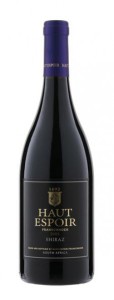
Haut Espoir Shiraz 2007
Yes, you guessed it. The time has come for another #SuperFANS Twitter tasting. We’ll be hashtagging it tomorrow night (Thursday 4 September) with SuperFANS from around SA, digging into their Haut Espoir stash and sharing thoughts, opinions, tasting notes and sprinklings of white people.. err… pepper… (you had to be there).
For those not in the know, SuperFAN Twitter tastings are a fun li’l thing we do every two months or so. Our gobsmackingly fantastic member farms treat us to a special fan pack, filled with liquid treasure. We then pick two or three wines from the packs and set them aside for tasting on the night. A date and time is agreed upon by all the SuperFANS and on the night, we take to Twitter from all over the country. We sniff, swirl, squint, tweet, type, drink, hiccup and gulp our way through the wines and the whole thing plays out real-time, online.
Our lineup for tomorrow night’s tasting is as follows:
2009 Gentle Giant
2007 Shiraz
Bonus round: 2008 Shiraz (to do a mini “vertical” tasting and compare years)
Last time around, we did #TasteLithos, possibly our most interactive tasting yet. 15,236 saw #TasteLithos and the potential reach was 26,958. That’s not half bad. And I think that #TasteHautEspoir will be topping those numbers.
If you’re NOT a SuperFAN, but you want to see what all the fuss is about, follow the hashtag #TasteHautEspoir from 19:00 on Thursday 4 September. If you have some of the Haut Espoir up for tasting lying around, feel free to join in! We’re not exclusive or snobby, we think we’re pretty cool. And if you want to become a SuperFAN and be in on the action with special fan packs, events and tastings, roll on over to our contact page and give us a shout, and we’ll add you to the list. No spam, nary a newsletter or unwanted content. Just super content.
The post #TasteHautEspoir appeared first on Incogvino.
]]>The post Crystal Clear: Wine & Wine Glasses appeared first on Incogvino.
]]>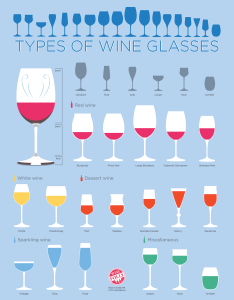
An Infographic illustrating types of wine glasses (via http://winefolly.com/tutorial/types-of-wine-glasses/)
A simple Google search will produce a mountain of results describing types of wine glasses, categorised for white wine, red wine, dessert wine, sparkling wine and others. The above infographic is a great little at-a-glance summary. So, why all the different shapes? And why match them with specific types of wine? Hard, irrefutable scientific evidence is scarce and flaky at best on this topic, but we’re pretty much OK with that. Science is great but in the end it comes down to your experience and not a study in some obscure journal. One fact that seems obvious and logical is the effect of the stem on the glass. Stemware allows the drinker to hold the glass without touching the bowl and increasing the wine temperature.
The general theory seems to be that the shape of the glass affects how the aromas from the wine reach your nose, thereby impacting how you experience the wine. Red wine glasses have a bigger bowl, which is thought to assist oxidation and opening up the wine. White wine glasses are comparatively smaller, as preventing rapid oxidation can help preserve a fresher flavour of delicate whites.
Dessert wines are served in small glasses. They generally have a very high alcohol content, so smaller serving glasses are desired but it may also be that the small glass directs the liquid further back onto the tongue, lessening the burning effect of the alcohol and increasing the perception of the sweetness.
For champagne glasses the popular choices are the flute or the coupe. The coupe is not as fashionable as it was a few decades ago but is still available. It was especially suited to build champagne towers as they shape allowed the flowing of the bubbly from the top, single glass into all the other in a rather spectacular fountain. The story goes that the original coupe design was shaped on the breast of Marie Antoinette, Madame de Pompadour or a number of other French aristocratic ladies of the time. While this is probably more fantasy than fact, tis a fabulous little tidbit.
The problem with the coupe is that the bubbly loses carbonation quite quickly because of the large surface area. The flute is seen as more elegant and sophisticated nowadays and is much preferred to the coupe. The narrow bowl also retains the carbonation more effectively, keeping your bubbly bubbling for longer and keeping bubbly lovers delighted.
But what about lead crystal vs. glass? Crystal is glass with lead monoxide added to it. This increases the refractory index of the glass. Simply put, it makes it more shiny and sparkly. Lead-free glassware is enhanced by the addition of alternative to lead monoxide, such as zinc- or magnesium oxide.
So where does that leave us in the great glassware debate?
With modern technology improving glassmaking techniques and modern trends affecting our tastes and designs, the choice of glassware available to wine drinkers today is expansive. Coloured glass, etched, embellished, stemless, oddly shaped or classic styles. You can buy them in boxes of 12 for a steal at your local shop or you can import them at eye-watering prices from the best glassware manufacturers in the world. But does it make a difference? That’s probably up to you. Sommeliers, Masters of Wine and other learned wine fundis are likely to insist it makes all the difference. If your nose isn’t quite as sensitive as theirs or your palate as particular, chances are the type of glass you use won’t affect your experience that much, if at all.
So try before you buy, see which you prefer and make sure they’re always filled with good wine.
The post Crystal Clear: Wine & Wine Glasses appeared first on Incogvino.
]]>The post Wine Review: Eagle’s Nest Shiraz 2010 appeared first on Incogvino.
]]>Nestled in the historical Constantia wine valley is the Eagle’s Nest estate. Purchased by the Mylrea family in 1984, the farm was nearly destroyed by the devastating fires that tore through the Cape in 2000. The historical buildings were spared from the destruction and in rebuilding the farm it was decided to plant varietals that are best suited to the terroir and climate of the valley.
This decision, combined with the non-traditional styles used by the winemaker, has proven successful. Of the 38 ha farm, only 14 ha is planted with vineyards. The main varieties are Shiraz, Viognier and Merlot. The varied soil types on the estate offer the ideal conditions for each varietal and the cool breezes that blow in from False Bay ensure enough cooling on hot afternoons.
As a rule, awards and accolades rarely influence my choice of wine. The awards and accolades bestowed upon the Eagle’s Nest Shiraz are, however, all justified. 5-star Platter ratings, gold medals and trophies everywhere, each and every one well-deserved.
The Shiraz has a very cool climate character, white pepper tones structured with red berries and dark fruits, rounded off with mocha and violets. Soft, gentle tannins impart the wine with a smoothness second to none.
Despite it’s relatively young age, this Shiraz is very drinkable right now but has great aging potential given it’s solid profile and fine tannin structure.
The estate also offers a Sauvignon Blanc, Viognier, Merlot and a red blend, the Verreaux. Eagle’s Nest estate also supports the Western Cape Raptor Research Programme, promoting the awareness and conservation of the Verreaux’s Eagle.
The post Wine Review: Eagle’s Nest Shiraz 2010 appeared first on Incogvino.
]]>The post Pinot Noir – that unexpected paramour appeared first on Incogvino.
]]>A confession. Until recently, I have never really known Pinot Noir. I knew it as a cultivar. I knew it was quite a light, red wine. I knew it was popular in other parts of the world. Yet I had never truly known it to be popular here. I must have encountered it in tastings over the years, but none so memorable as to stand out or encourage me to pursue this slightly unusual varietal.
I have, I fear, been missing out.
A chance discussion with friends brought up the topic of this underrated cultivar, with one friend in particular waxing lyrical, calling it a ‘seductive mistress’. I was intrigued. My affections have moved, as they do, from cultivar to cultivar over the years. Merlot was my first love, whereafter Shiraz ripped me away for a whirlwind but short-lived relationship. Cabernet is the patient, trustworthy lover always ready to take me back. And I have ongoing romances with complex Sauvignon Blancs and rich, decadent Chardonnays, often interrupted by exotic dalliances with Malbec, Grenache and Mourvédre.
But Pinot Noir. She seemed so…unremarkable.
Cue last week, when I rounded up 5 bottles and an equal number of friends, convinced to delve deeper into this mysterious wine that has been off my radar for so long. I did some research, considered my budgetary constraints and picked a selection that would hopefully cover a range of different styles and tastes. I used my friends to crowd-source some opinions and the “score” out of 5 indicates how many of us would choose to purchase this wine in future.
Note: I won’t bore your with technical details about Pinot Noir as a cultivar. If you are totally unfamiliar with it, all you need to know is that the berries are quite small and have a very thin skin, making a very light-coloured wine, usually with very little tannins. The hue and clarity is near that of a rosé, perhaps slightly darker, and even more so when wooded. In South Africa, the best Pinot Noirs generally come from the Hemel-and-Aarde Valley as well as Elgin, with the cooler climates suiting the cultivar down to the ground.
First up was the Haute Cabriére Unwooded Pinot Noir 2011 (R91). Remarkably light, only slightly darker in colour than an average rosé. Fresh red berries all over the place, like biting into a ripe cherry, thought the fruity fragrances don’t quite translate to the tongue. Gloriously light. A wine for summer days. Served chilled with salads, pastas and even a light braai. 4/6
We moved on to the Felicité from Newton Johnson Family 2012 (R87). Sweet, sweet nose with more fruity red berries. More complex than the Haute Cabriére, this wine could work well with pairings. 14% alcohol seems high but is masked very well by the innate complexity in the wine. Consensus was that it might be even better if left to age for 2 years. 2/6
Arguably the favourite for the day turned out to be Mr. P from Iona 2012. A description from the table was “it’s like it has an under-wire, it gives it support and shape”. Deep cherry both on the nose and the tongue, with a hint of spice. Perfectly rounded from ageing in 2nd, 3rd and 4th fill barrels. An unequivocal 6/6
After breaking for lunch, we approached the slightly more serious candidates. The David Finlayson 2012: Small Batch Series (R125) showed bursts of strawberry, with a touch of vanilla (almost caramel) flavours. Perfectly quaffable now, but this one should age incredibly well. 4/6
We ended off with the Waterford Pinot Noir 2011. This one fell a bit flat. Darker fruits and berries emanate from the glass, but the high tannins cause it to fall flat on the palate. Possibly ageing will curb the effect and soften it up a bit. Not a bad wine, but definitely more for pairings than general consumption. 1/6
The wines explored here seem to be a good way to introduce oneself to this marvelous cultivar. Tastes, as always, differ greatly. And the variety of Pinot Noir available is as extensive as it is diverse. She’s not everyone’s cup of vino. But if she is, you’ll never shake her. I can testify to that.
If you want to continue your own Pinot Noir education, I would recommend the following wines:
• Bouchard Finlayson Galpin Peak Pinot Noir (R297)
• Creation Pinot Noir 2012 (R189)
• Hamilton Russell Pinot Noir 2010 (R317)
• Newton Johnson Family Vineyards Pinot Noir 2011 (R255)
• Paradyskloof (Vriesenhof) Pinot Noir 2011 (R122)
• Vriesenhof Pinot Noir 2010 (R254)
The post Pinot Noir – that unexpected paramour appeared first on Incogvino.
]]>